
The German People's Party was a conservative-liberal political party during the Weimar Republic that was the successor to the National Liberal Party of the German Empire. Along with the left-liberal German Democratic Party (DDP), it represented political liberalism in Germany between 1918 and 1933.
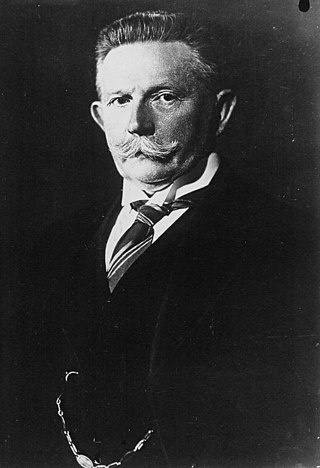
Alfred Ernst Christian Alexander Hugenberg was an influential German businessman and politician. An important figure in nationalist politics in Germany during the first three decades of the twentieth century, Hugenberg became the country's leading media proprietor during the 1920s. As leader of the German National People's Party, he played a part in helping Adolf Hitler become chancellor of Germany and served in his first cabinet in 1933, hoping to control Hitler and use him as his tool. The plan failed, and by the end of 1933 Hugenberg had been pushed to the sidelines. Although he continued to serve as a guest member of the Reichstag until 1945, he wielded no political influence. Following World War II, he was interned by the British in 1946 and classified as "exonerated" in 1951 after undergoing denazification.

Franz Joseph Hermann Michael Maria von Papen, Erbsälzer zu Werl und Neuwerk was a German conservative politician, reactionary, diplomat, Prussian nobleman and General Staff officer. He served as the chancellor of Germany in 1932, and then as the vice-chancellor under Adolf Hitler from 1933 to 1934.

The Centre Party, officially the German Centre Party and also known in English as the Catholic Centre Party, is a Christian democratic political party in Germany. Influential in the German Empire and Weimar Republic, it is the oldest German political party in existence. Formed in 1870, it successfully battled the Kulturkampf waged by Chancellor Otto von Bismarck against the Catholic Church. It soon won a quarter of the seats in the Reichstag, and its middle position on most issues allowed it to play a decisive role in the formation of majorities. The party name Zentrum (Centre) originally came from the fact that Catholic representatives would take up the middle section of seats in parliament between the social democrats and the conservatives.

The German National People's Party was a national-conservative and monarchist political party in Germany during the Weimar Republic. Before the rise of the Nazi Party, it was the major nationalist party in Weimar Germany. It was an alliance of conservative, nationalist, monarchist, völkisch, and antisemitic elements supported by the Pan-German League. Ideologically, the party was described as subscribing to authoritarian conservatism, German nationalism, monarchism, and from 1931 onwards also to corporatism in economic policy. It held anti-communist, anti-Catholic, and antisemitic views. On the left–right political spectrum, it belonged on the right-wing, and is classified as far-right in its early years and then again from the late 1920s when it moved back rightward.
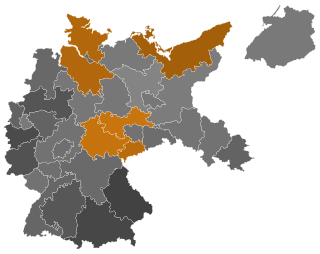
Presidential elections were held in Germany on 13 March 1932, with a runoff on 10 April. Independent incumbent Paul von Hindenburg won a second seven-year term against Adolf Hitler of the Nazi Party (NSDAP). Communist Party (KPD) leader Ernst Thälmann also ran and received more than ten percent of the vote in the runoff. Theodor Duesterberg, the deputy leader of the World War I veterans' organization Der Stahlhelm, ran in the first round but dropped out of the runoff. This was the second and final direct election to the office of President of the Reich, Germany's head of state under the Weimar Republic.

Federal elections were held in Germany on 31 July 1932, following the premature dissolution of the Reichstag. The Nazi Party made significant gains and became the largest party in the Reichstag for the first time, although they failed to win a majority. The Communist Party increased their vote share as well. All other parties combined held less than half the seats in the Reichstag, meaning no majority coalition government could be formed without including at least one of these two parties.

Federal elections were held in Germany on 14 September 1930. Despite losing ten seats, the Social Democratic Party of Germany (SPD) remained the largest party in the Reichstag, winning 143 of the 577 seats, while the Nazi Party (NSDAP) dramatically increased its number of seats from 12 to 107. The Communists also increased their parliamentary representation, gaining 23 seats and becoming the third-largest party in the Reichstag.
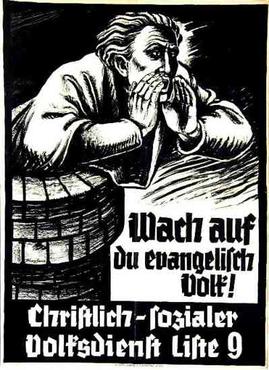
The Christian Social People's Service was a Protestant conservative political party in the Weimar Republic.
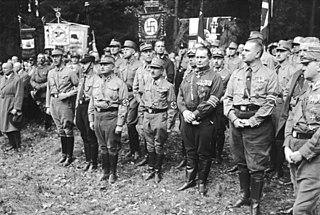
The Harzburg Front was a short-lived radical right-wing, anti-democratic political alliance in Weimar Germany, formed in 1931 as an attempt to present a unified opposition to the government of Chancellor Heinrich Brüning. It was a coalition of the national conservative German National People's Party (DNVP) under millionaire press-baron Alfred Hugenberg with Adolf Hitler's National Socialist German Workers' Party (NSDAP), the leadership of Der Stahlhelm paramilitary veterans' association, the Agricultural League and the Pan-German League organizations.
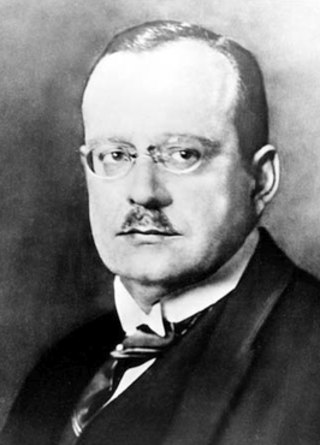
Paul Adolf Franz Lejeune-Jung, was a German economist, politician, lawyer in the wood pulp industry, and resistance fighter against Adolf Hitler's Third Reich.

Gottfried Reinhold Treviranus was a German politician from the Conservative People's Party and a Reichsminister in both of Chancellor Heinrich Brüning's cabinets. In the first he was Minister for the Occupied Territories and then Minister without Portfolio ; in the second, he served as Minister of Transport.
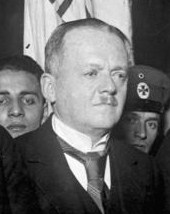
Count Kuno Friedrich Viktor von Westarp was a conservative politician in Germany.
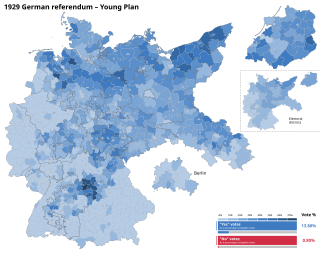
The 1929 German Referendum was an attempt during the Weimar Republic to use popular legislation to annul the agreement in the Young Plan between the German government and the World War I opponents of the German Reich regarding the amount and conditions of reparations payments. The referendum was the result of the initiative "Against the Enslavement of the German People " launched in 1929 by right-wing parties and organizations. It called for an overall revision of the Treaty of Versailles and stipulated that government officials who accepted new reparation obligations would be committing treason.

The Papen cabinet, headed by the independent Franz von Papen, was the nineteenth government of the Weimar Republic. It took office on 1 June 1932 when it replaced the second Brüning cabinet, which had resigned the same day after it lost the confidence of President Paul von Hindenburg.

Martin Schiele was a German nationalist politician. He was part of the leadership of the German National People's Party (DNVP) from its 1918 founding until Alfred Hugenberg became leader in 1928. He was also the chief representative of the agrarian wing of the DNVP. As a member of Hans Luther's coalition government, Schiele secured the restoration of agricultural and industrial protectionism with the tariff of 1925. As minister of food in 1927–28, he favored state credit as a means for subsidising agriculture.

The von Schleicher cabinet, headed by Chancellor Kurt von Schleicher, was the 20th and last government of the Weimar Republic. Schleicher assumed office on 3 December 1932 after he had pressured his predecessor, Franz von Papen, to resign. Most of his cabinet's members were holdovers from the Papen cabinet and included many right-wing independents along with two members of the nationalist German National People's Party (DNVP).

The presidential cabinets were a succession of governments of the Weimar Republic whose legitimacy derived exclusively from presidential emergency decrees. From April 1930 to January 1933, three chancellors, Heinrich Brüning, Franz von Papen, and Kurt von Schleicher were appointed by President Paul von Hindenburg, and governed without the consent of the Reichstag, Germany's lower house of parliament. After Schleicher's tenure, the leader of the Nazis Adolf Hitler succeeded to the chancellorship, ending the Weimar Republic.

The first Brüning cabinet, headed by Heinrich Brüning of the Centre Party, was the seventeenth democratically elected government during the Weimar Republic. It took office on 30 March 1930 when it replaced the second Müller cabinet, which had resigned on 27 March over the issue of how to fund unemployment compensation.

The second Brüning cabinet, headed by Heinrich Brüning of the Centre Party, was the eighteenth democratically elected government during the Weimar Republic. It took office on 10 October 1931 when it replaced the first Brüning cabinet, which had resigned the day before under pressure from President Paul von Hindenburg to move the cabinet significantly to the right.






















